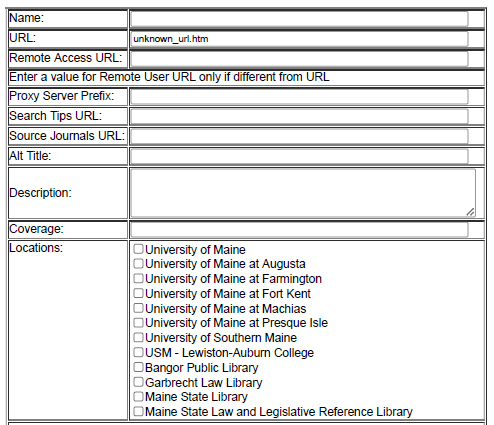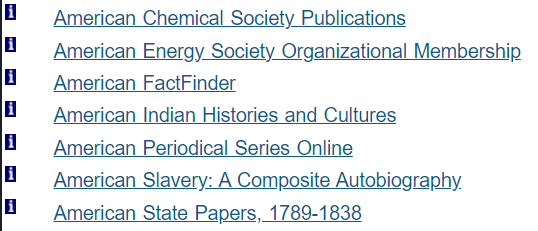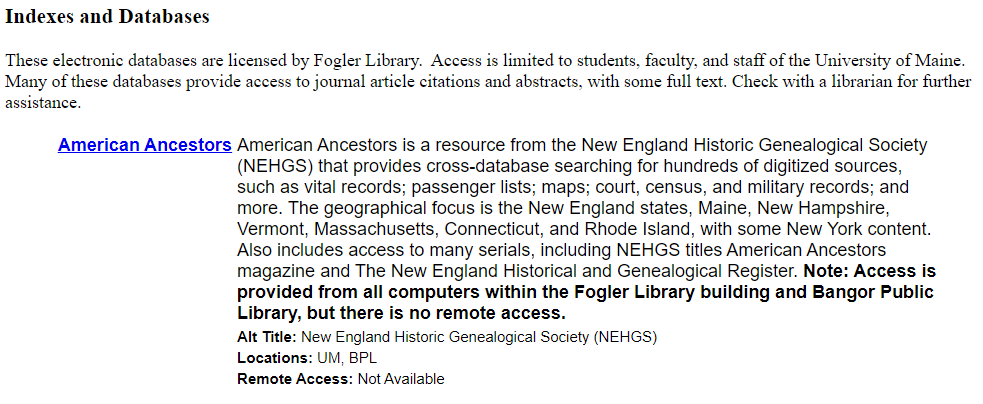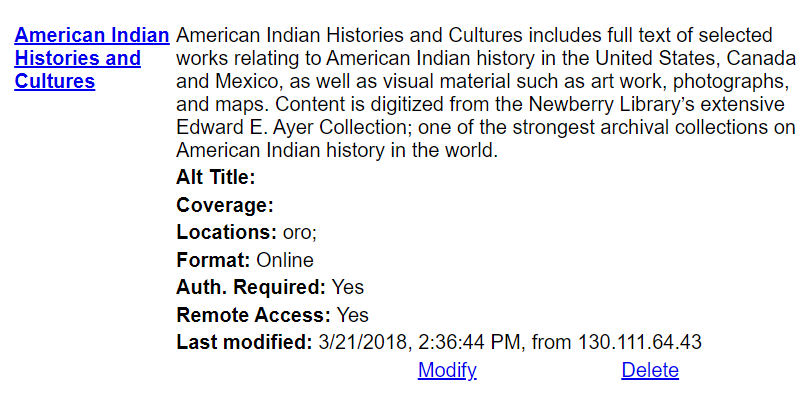ERM: Managing UM Indexes and Databases (IDB)
Add New | Edit Existing | Check Work | Cataloging | EZ Proxy | Link Check | Troubleshooting
Purpose: To record the procedure for managing Indexes and Databases.
Overview: Index and Database (IDB) titles subscribed to by the University of Maine are managed by Fogler Library staff. System-wide and statewide subscription resources are managed by Maine InfoNet. Requests to add new titles to the IDB interface will typically come from Deb Rollins, Head of Acquisitions. These requests should provide all the following information:
- Resource Name
- Resource URL
- Remote User URL (if different than Resource URL)
- Search Tips URL (if available)
- Source Journals URL (if available)
- Alt Title (if available)
- Description
- Coverage
- Locations (if more campuses than just UMaine)
- Subject Headings
- Resource Genre
- Vendor or contact information
Check for Duplicate Titles
- Before adding a new title, check the list of existing Indexes and Databases to confirm the title has not been entered by another staff person.
- Check the list of Indexes and Databases in Mariner for title or title variations.
- Search URSUS to be sure a minimum-level record has not already been created; consider title variations.
Add a New Title to Indexes & Databases
Go to the IDB web interface and login with your user name and password.
- At the top of the list of the IDB titles, click the “Add a record” text link.
- In the subsequent data input form, enter the official name of the IDB resource.
- Enter the access URL provided by the publisher in both the URL and Remote Access URL fields.
- Add URLs for search tips or source journal lists provided by publishers.
- Enter any alternative title in the “Alt Title” field.
- Enter the text description in the “Description” field. This field has a limited number of characters, so descriptions must be succinct. The description field can recognize html formatting code to create italic, bold, or underlined text, which Deb occasionally requests. For assistance with text formatting, please see HTML Text Formatting from W3C.
- Enter the dates for coverage for the resource.
- Under “Locations,” check the boxes next to University of Maine and University of Maine at Machias unless provided specific instruction to the contrary.
- Check the boxes beside the appropriate subject headings.
- Check the boxes next to the appropriate genre of resource.
- Under “Format” enter “Online.”
- Select the appropriate Vendor from the drop-down menu. This information can be helpful to staff when troubleshooting access issues.
- Enter a contact person’s name and email for the vendor, if available. This will assist staff when troubleshooting.
- Check boxes:
- This is a feature database (ignore, related to old portal)
- Catalog in URSUS (check this box to indicate that this the title should be or is cataloged in URSUS)
- System-wide generic database (check this box for open access resources)
- Requires User Authentication for Access (check this box for all subscription resources that require user authentication)
- Sites using referring URL for authentication (rarely used in 2020s)
- Site uses ID and Password for remote user authentication (double-check with Tim Pellet at Maine InfoNet for guidance)
- Connect-to page is required (rarely used)
- Connection information is campus-specific (applies to only system-wide resources that have specific campus logins)
- Suppress display of this record (Maine InfoNet prefers this option be used to suppress records only briefly while working with them. Delete records for cancelled resources rather than suppressing them.)
- Enter your initials and “oro” in the “Modified by” field, for example “kjs-oro”
- Click the “Submit” button.
Checking Your Work and Testing Links
- Navigate to the Indexes and Databases webpage.
- Click on the blue, lower-case “i” information icon.
- Review the database description for typos and formatting issues. Test any links present.
- Test the resource link to confirm access is available. If you receive a proxy error, you’ll need to submit a ticket to Maine InfoNet requesting a config file update.
Current EZ Proxy stanzas are available through OCLC.
Edit Existing Indexes & Databases
Go to the IDB web interface and login with your user name and password.
- After logging in, click the “List Titles” button for “All Titles” to retrieve the full list of titles.
- Use your browser’s find function to search the full list for the title you are editing.
- Under the title summary list, click the “Modify” text link.
- Edit the data fields as necessary in the subsequent interface.
- Click the “Submit” button at the bottom of the form.
- Test the title link to confirm that access is available.
Troubleshooting Before There’s Trouble
A title change in will cause an existing URSUS record link to break. Overlay any existing URSUS record with an updated record and generate a new link, described below.
If a database listing is deleted, Deb should notify Nancy Lewis so that it can be removed from the LibGuide A-Z Database List.
Once a title is functioning correctly, forward the link information to staff in the Cataloging Department to address the following steps.
- Check for an existing minimal level record (MLR) with an order record attached.
- Catalog the IDB title in URSUS (or update existing bib record)
- If creating a record for export from OCLC, enter any authenticating URL only after the record has been brought over to URSUS
- If an MLR exists, overlay that document with the new bib record.
- If exporting a record from OCLC, include a 949 3 3 line
- Return to the IDB Staff Interface; hover over the appropriate, named link; right-click and ‘Copy link location’ and add as an 856 4 1 line in URSUS
- The URL will read http://libraries.maine.edu/auth/auth.asp?db-[Title]
- In the event that a title change causes a record to be overlaid and a new URL generated, Deb should notify Nancy Lewis so that links in the LibGuide A-Z Database List may be updated accordingly.
Responsibility for editing the proxy config file is now exclusively the responsibility of Maine InfoNet. Submit information and requests for new listings to Tim Pellet through the Maine InfoNet ticketing system.
Notify UMS Library Community (ONLY IF a resource is free or licensed system or statewide)
Send a notice via the URSUS listserv, URSUS@LISTS.MAINE.EDU: [ “UMaine has added the following open-access databases to Mariner and URSUS. As these are free resources, please feel free to add your library to URSUS and the IDB record.” ]. Provide the resource title and a copy of the permanent link from URSUS in the e-mail.
Shared Subscription IDB Resources
For Indexes and Database subscriptions that apply across multiple campuses, a request must be sent to Maine InfoNet via the online Ticket system. Include all pertinent information from the submission form or email to the ticket “Description” field.
Preventative troubleshooting can be accomplished by checking each title on the Indexes and Databases list prior to the start of each semester. The easiest way to do this is to login to the staff interface and instead of reviewing all titles, scope the databases to only those available in Orono.
Gradually work your way through the list by clicking on the resource title and completing all logins required to access the resource.
Troubleshooting Indexes and Databases
Reports of trouble from patrons are typically channeled through the “Chat with a Librarian” feature on the Fogler website. Other times, access issues may be reported directly to you via email or by phone. Consistently request the following information prior to attempting to troubleshoot.
- The name of the electronic resource attempting to access (database, electronic journal, ebook)
- A complete citation for the item the patron is attempting to access
- What platform is the patron using (Windows version; Mac OS version)?
- Which browser is the patron using (e.g., Firefox, Safari, Edge, Chrome)?
- A screenshot of the error being encountered, including the URL
- The patron’s contact information
There are many variables involved when troubleshooting electronic resources. Following are examples of the most frequently encountered issues that prevent access to a subscription resource. Before contacting any publishers to make access inquiries:
Test your own access to the resource. Can you recreate the problem being reported?
-
- No? Double-check the resource citation again to make certain you have a 1:1 match.
- No? Check the resource using a different browser.
- Still no? Check the URL in the image sent by the patron to see if they were proxied when attempting to access the resource.
- Let patron to know you are unable to replicate the error they report. Instruct the patron to clear their browser cache, cookies, and history. Close out. Re-launch and try again. It was likely a temporary glitch on the publisher’s end or a previous, unresolved session lingering in the browser.
Yes, you can recreate the problem
Check the publisher’s status webpage for any known issues or outages. Additional pages may be located by searching the publisher’s name and the phrase ‘system status’, ‘site status’, or simply ‘status’ using Google. For publishers that do not provide status pages, enter the publisher’s base URL in the Search Outages website included below.
- EBSCO Status Site
- Ex Libris (Clarivate) Status Site
- Gale
- OCLC System Status
- ProQuest Status Site
- Sage Publishing
- Search Outages
- Wiley Plus
Confirm the status of Fogler Library’s subscription
- Is the subscription active or was it cancelled? [Cancelled: Refer patron to ILL]
- Was payment sent?
- Was payment received?
- What is the coverage? Does the resource fall within the subscription coverage? [No: Refer patron to ILL]
- Was the title dropped from a subscription package?
Confirm the resource URL is correct
Roughly 75% of publishers contact subscribers in advance of server migrations that result in a change in the landing URL.
- Register with publisher websites and sign up for newsletters issued by each publisher, so you have access to the 75% who send out notifications related to known issues (changes in URLs, planned outages, etc.).
- Take time to search a publisher’s website for announcements or press releases announcing changes with the service provider.
-
- It’s a known outage on the publisher’s end. Notify the patron. If the outage is impacting a heavily used resource, send an email to notify library staff of an existing outage.
- Update the known issues web page.
- Continue to monitor. Once access is restored, notify the patron, library staff, and remove the notice on the known issues web page.
-
None of the Above
Once you’ve established that Fogler Library patrons should have access to the paid subscription resource and that there is no larger outage impacting the publisher, it’s time to dig for contacts and/or technical support information specific to the publisher in question.
Contact: um.library.technical.services@maine.edu
Return to Technical Services Table of Contents.





